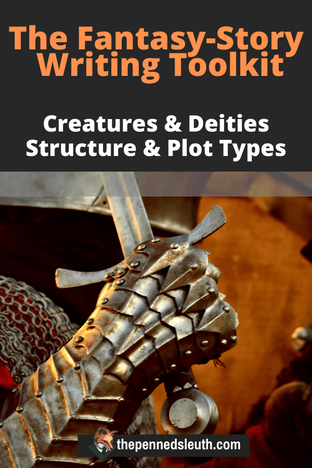Latest Writing Video! |
|
One can’t sum up fantasy with world types and magical systems; there is a lot more to talk about. In this second part, we will be discussing creatures, races, deities, world structures and plot types. I go through some of the best methods for writing these fantasy elements, as well as different examples and which ones suit your story best. With that said, let’s begin! Pin for Later!NOTEThis is the second part of this series, so if you haven’t already, be sure to check out the first part. In that post we cover the bigger picture of your fantasy world, discussing world types and magical systems. There is also a discussion on how to name everything if you plan to create a massive, in-depth world. And if you are looking for some hands-on practice or guidance with their novel, I recommend checking out my writer's workshop. There are various options for you to choose from, like enrolling in my writing courses, joining the writing group or joining my tutoring program. Creatures, Races and Deities:One important element of your world is its occupants. One of the top three worth discussion is the people, the creatures and possibly the deities, the gods, which play a role in the world’s development or your story. Let’s start with discussing the simplest elements of the three; the creatures. CreaturesIn most fantasy novels you will find the standard mythical creatures, from dragons to goblins. These are the creatures we have all read about before or seen in other forms of media. For writers, these creatures are either familiar enough to them to explain, or familiar enough to the target market that much explanation and description is not needed. These are creatures that are accepted by the reader with minimal introduction and description, which is great for beginner writers. Of course, you can still create an array of creatures of your own. Some writers go out of their way to create monsters straight from their nightmares or magical creatures from their happiest dreams. If you decide to do this, then things get a little bit more difficult, but here are some tips to make the process easy. First, describing the creature can be made simple by comparing the creature with common animals. Is the monster as big as an elephant? Does the creature dart around in the air like a hummingbird or gracefully swoop like an eagle? Are the pupils pointed like that of a snake? Does it have large, lumbering movements like a bear or fast, frantic movements like that of a spider? You can use these comparisons to easily describe the structure and behaviour of your creature. It’s much easier than trying to describe your creature from scratch, which is to say it is not impossible, but this method is easier. Secondly, establish the name and location of this creature. Can it typically be found in caves, forests, or even a specific region of your world? What is it called? And if you wish to add further depth, who named the creature and why? Yet, one of the first factors you need to consider is what kind of feeling you want your world to have. You might create creatures too dark or too light for your story, so be careful in how you construct and present them. Again, this is another reason why most writers stick with what is already known in fantasy, as the world and story they have in mind suit the classic creatures found in fantasy. RacesNow, fantasy races have always been a beloved trope in high fantasy. From the elves and their finery to the dwarves and their down-to-earth personalities. Of course, there are more races than the common elves and dwarves, but that depends on the ones that appeal to you. You can have a race of stone golems, fluttering fairies, sinister demons, werewolves, vampires and more. When you are creating a world from scratch, there is no limit to the number of races you can include in your world space and their place in the social hierarchy, something we will be talking about a little later. For now, know that there is no limit to what you can include in your world, but managing all these races and their relationships with each other becomes exponentially more complicated with each one you add. If you plan to create a grand scale conflict during your story, or include such a conflict in your world’s history, be sure to consider the sides that different races often take. While there will no doubt be exceptions, with some people from respective races fighting on the other side, it is typical in fantasy for races to fight for their own as there is a sense of kinship. That is a conversation that is a lot more complicated than it sounds and becomes very dangerous to discuss if taken too seriously, so moving on! Races are a great way to diversify your world. Be sure to consider the natural talents of each, their preferences and their beliefs. Fantasy races will have certain differences that make them a bit more adept at certain tasks. For example, fairies, being dainty things the size of birds, aren’t fantastic at lifting great weights on their own, but are fantastic at spying and sneaking past threats unnoticed. Dwarves may not win any high-jump medals, but their skills with smithing are unmatched. You could have a lot of fun with this, you can even break some stereotypes to make them more unique in your story. DeitiesFantasy generally includes many figures of power. Characters who have incredible strength, or are magic users and so on. Yet, it doesn't get more powerful than figures who are considered gods in their universe. These don’t necessarily have to be characters in your world, but deities have a place in any culture and any fantasy world. It’s a common, human phenomenon to want to believe in something greater than themselves, from the deity in charge of the winds and tides to the deity that created all they see. While it is not necessary to add gods to your world, it can add a bit more depth to it. You could include it on the small scale, simply referring to the gods through conversation or in shocked exclamations. Or, you can use deities as a core element of your plot, perhaps as characters who are threatened by greater power or perhaps they are the antagonist in your story. There are many options. Yet, some advice when writing deities, consider this role they play well. If they are going to be a core element of your plot, you will need to explore their intentions, their desires in the story. What is their ultimate goal? What is their personality fault? Treat them as you would any other character in your story, or they will feel flat and uninteresting. Like races and creatures, deities can add a lot to your story, but if done poorly, will only take away. Of all three, decide which ones you want to include and know that the more you add, the more careful you need to be when presenting everything to your reader. You don’t want to introduce everything at once and bog them down in explanations. Of course, that’s a rule that will apply to everything we will be talking about today! Fantasy World Structure:Having all the pieces is only the beginning, you now need to decide their place on the board and the roles they play in your fantasy world. I am talking about the structure of your world and how all these various elements interact with each other. The structure of society is crucial if you plan on writing a story with large conflicts or if your main character goes through various places, experiencing their differences. Establishing HierarchyOne way you can establish society quickly is by creating what is known as a hierarchy. Creating a simple diagram of who is on top and who is on the bottom. For example, you could have three kingdoms of various sizes and levels of importance. The largest or most powerful kingdom would be placed on top of this diagram. The least powerful would be placed on the bottom and the remaining kingdom would be in the middle. From there, you can establish relations. Perhaps the middle kingdom and the lower kingdom have a strong alliance, with more collective power and numbers than the high kingdom. Now, that’s a really simple example, but you get the idea. You could have various branches in your diagram, linking different groups, be they towns, cities, kingdoms or even deities, if you plan to include gods in your story and have their influence known in this hierarchy. It is also from this tiered program of groups that society will be established, as well as the common interactions between these groups. HistoryIf that isn’t in-depth enough for you, you can also take history into account. Now, history is a big part of any lore system and I will be discussing lore more in the final part, but know that history plays a key role in establishing how each group is placed on the hierarchy. If a group is placed high in the hierarchy, one can look to their history as to how that came to be; usually, it is the victories and alliances they made over the ages. Now, like most of these world-building features in fantasy, you don’t need to go so in-depth that you start writing a novella filled with world history. You can mention various events vaguely during the story, providing little information other than the reason behind the event and the result. Once more, this depends on how much world-building you are interested in doing. Let me know how in-depth you like to make your lore in the comments below! Consider the StoryWith that said, I would like to remind the most verbose of writers to consider the story. You might be tempted to jump in the deep end and start planning out a ludicrously diverse and wonderful fantasy world, with various notes that you can refer to when writing your book. It’s something I have often been tempted to do in the past. Yet, it is always important to consider the story first, as all these notes and in-depth planning might go to waste if it jeopardizes your story. A story and its characters should come first. The various plot points should be respected if you feel like you have a great story in the making. Only from there should you explore deeper into worldbuilding. This leads me to another question for you; would you prefer a deeply immersive world over a gripping, enjoyable story? Of course, having both would be nice, but humour me by sharing which one you prefer over the other. Prophecies, Rise of Heroes & Other Plot Types:Speaking of stories, let’s discuss the different plot types which commonly appear in the fantasy genre. Don’t worry, I won’t discuss the different variations of each or bore you with so many details because, at the end of the day, you have to write your story on your own. These different types, or tropes, are the ones you are already familiar with and have seen in various popular fantasy novels. Let’s start with a classic! PropheciesProphecies are fun to write for two major reasons. First, it lends the idea of greatness to the main characters, letting all those in the story, as well as the reader, know that the main character is destined to do great things. The prophecy says they will be the ones to defeat the antagonist, they will be the ones to end wars, they will be the ones to unite the world and usher in an age of everlasting peace; the usual. Secondly, it makes the job easier for the writer. If there are moments in the story where it seems that the protagonist shouldn’t have survived, yet they did, it all comes down to the prophecy and not the superior power of plot armour. A writer is a bit freer when constructing these situations, going for more incredible scenarios to make the story interesting, rather than grounded scenarios to ensure the story makes sense. This is not a bad thing. Fiction is supposed to be a creatively freeing genre and fantasy is one of the most freeing of all. Yet, prophecy is more an element of plot type, let’s talk about another common plot! Tragic Past, Rise to PowerThe protagonist is separated from their loved ones, perhaps kidnapped, or their loved ones killed. It instilled a sense of justice in the main character, a moral desire to put a stop to all the bad people who make people feel a similar pain. Along the way, they learn new skills, grow stronger, make allies, until they are leading an ultimate charge against the BBEG and their army of baddies. Sound familiar? It should, it is the story of almost every fantasy story and for a good reason. It’s a story of those who have hit rock bottom finding inner strength and reaching great heights. Most of the time the protagonist will go through some learning curves when it comes to their ego, but otherwise, they remain largely the same on their campaign for peace. Typically, these are the plots that most writers lean on, as these are the most inspiring. A reader is searching for an escape from the mundane and depressing, at least most readers are, which is why these plots combined with the right world and writing make for truly enjoyable stories. You would be hard-pressed to find a fantasy novel reader who doesn’t enjoy a story about a poor kid unfairly treated by the world to find happiness and do all they can to defend it. Grand-Scale ConflictA plot type that is popular with writers who like to create an in-depth world with various factions is one involving grand-scale conflict. It could be various groups fighting in the streets or entire armies fighting on a massive battleground. Grand-scale conflict inspires awe as the reader imagines the losses and the rewards. While most fantasy conflicts are good vs evil, you can create more conflicts that are brought about by a multitude of reasons between two or more nations that can both be considered good and bad. In other words, a more realistic conflict which has the reader taking sides not based on the characters representing each nation, but on the values that these nations fight for. The greatest difficulty one might have writing grand-scale conflict is realistically bringing the conflict about and also describing the battle when it happens. Here is some advice for both possible obstacles. First, the reason/s behind the conflict. Realistically, a conflict is brought about by several events that stoke the aggressions of each nation. It could be several deaths or a few deaths of very important figures to that society. It could have something to do with breaking treaties and so on. In a lot of novels where it is difficult to make each nation naturally commit these aggressive acts, the writer will create a third faction that uses sabotage to bring about these acts. There is always a limit to which a nation can deny its involvement before the victim of the transgressions considers them an enemy. There you have it, realistic conflict! Second, how to describe large battles. There is no getting around it, you can’t simplify it enough to help readers imagine. It is one of the occasions when you need to take your time, set the scene, describe numbers and actions in-depth. You can spend up to a page or two painting the picture if you wish because grand-scale conflict needs it. With that said, a great way to tone things down into more specific scenes is first by starting big and working your way down. Talk about the area, then talk about the numbers, go through an assortment of different responsibilities that some soldiers play, until you are finally addressing a specific character important to the story, continuing with a scene on them. Another way to look at it is to imagine yourself as a camera, high in the sky, giving a slow panning shot of the battle, but zooming in closer and closer to one character until your shot is fixed on them and their actions. Travelling AdventurersNow, the most simple plot top is a long journey with an assortment of small adventures. Usually, this is the plot type that leads up to the grand scale conflict, but it can easily be a plot on its own. The story follows a character going off to complete some task, be it off to save someone or to carry a message to someone important. The journey is long, filled with various stops and encounters. The character will meet a lot of people, good and bad. The character will help those they can or defeat/escape those who mean to do them harm or jeopardize their mission. The main character might even make a few friends along the way, building their party of like-minded heroes. The travelling adventures plot type is excellent for writers who want to create a more relaxed, down-to-earth experience. Everything is about living in the moment, doing what one can in each situation and working towards the best result. It makes for excellent character development, with lessons being taught along the way. Of course, you can include more fantastic moments, but the character continues their journey to the end. You can always continue the story after they reach their destination, as their goals might have developed into something greater after their journey. That’s all up to you. End of Part 2 - What Next?There you have it, several plot types and ideas that might appeal to you. Yours might be entirely different from these common types, but all the same, which one is your favourite? What kind of plot do you enjoy reading in the fantasy genre?
I hope you enjoyed the second part of this series. These toolkits contain ideas and tips, options and paths for you to consider. I wish you all the best with your choices! In the next part, I will be discussing lore a bit more in-depth and the common characters one finds in fantasy novels. If you have anything you wish to add to the subject I discussed in this article, let me know in the comments. And for the writers enjoying the series, but are looking for some hands-on practice or guidance with their novel, I recommend checking out my writer's workshop. There are various options for you to choose from, like enrolling in my writing courses, joining the writing group or joining my tutoring program. Thank you and as always, Good day, goodnight and happy writing!
0 Comments
Leave a Reply. |







